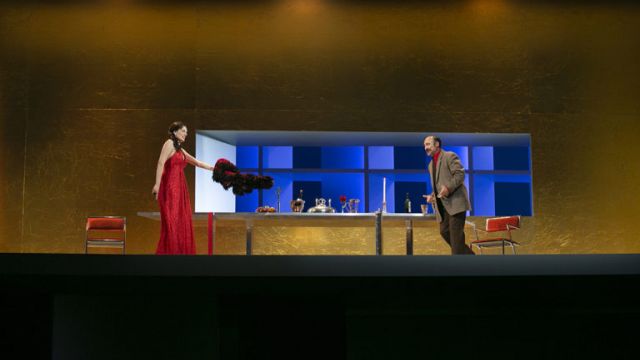Tosca
Opera Queensland’s Artistic Director Patrick Nolan tell us in his notes that “this is the first new production of Tosca presented in Australia for many years”, and what a triumph it was. His idea to re-imagine Puccini’s moody, melodramatic masterpiece in terrorist-torn Italy of the 70s paid off handsomely with some exemplary vocals, emotion-charged acting, a gorgeous orchestral realisation of the score, and all played out on a striking modernist two-level set.
Singing the title role for the first time, New York based Australian soprano Rachelle Durkin was self-assured and powerful, with a ton of Latin fire and ripples of vulnerability. A tall, statuesque beauty, she had no trouble flicking between jealousy and love as the part demands, and brought uncontrolled horror to her grief when her lover is being tortured. She captivating with a restrained “Vissi d’arte” (I Have Lived for Art) which was a highlight.
 Angus Wood sang Cavaradossi with clarion tenor tones, vocally delivering the best performance of the night. Tall and handsome, he was a good match for Durkin, which made their romantic coupling all the more believable.
Angus Wood sang Cavaradossi with clarion tenor tones, vocally delivering the best performance of the night. Tall and handsome, he was a good match for Durkin, which made their romantic coupling all the more believable.
The corrupt and sadistic Chief of Police, Baron Scarpia was in the hands of Argentine-Australian baritone Jose Carbo, who revelled in the lecherous and ‘bad-boy’ traits of the character. Sanctimonious and crude, whether whispering lasciviously in Tosca’s ear or brutally ordering her lover’s torture, his interpretation was awash with menace. The psychological dynamics between the three principal characters was impressively realised by Nolan’s direction which gave the performances an added layer of depth.
Dale Ferguson’s set filled the Lyric stage and worked brilliantly for the grandeur of the church, the box-like police headquarters, and the torture scenes shown in excruciating detail behind frosted glass. His costumes mirrored the period with thankfully limited use of flares.
Conductor Oliver Von Dohnanyi’s baton work was masterful and the orchestra respondied with a performance of exhuberance. The end of act-one “Te Deum” was spectacular and alive with religious pomposity. Filling the stage with bodies, it gave the chorus and children’s chorus their moment in the spotlight of this very grand and very exciting production.
Peter Pinne
Subscribe to our E-Newsletter, buy our latest print edition or find a Performing Arts book at Book Nook.

